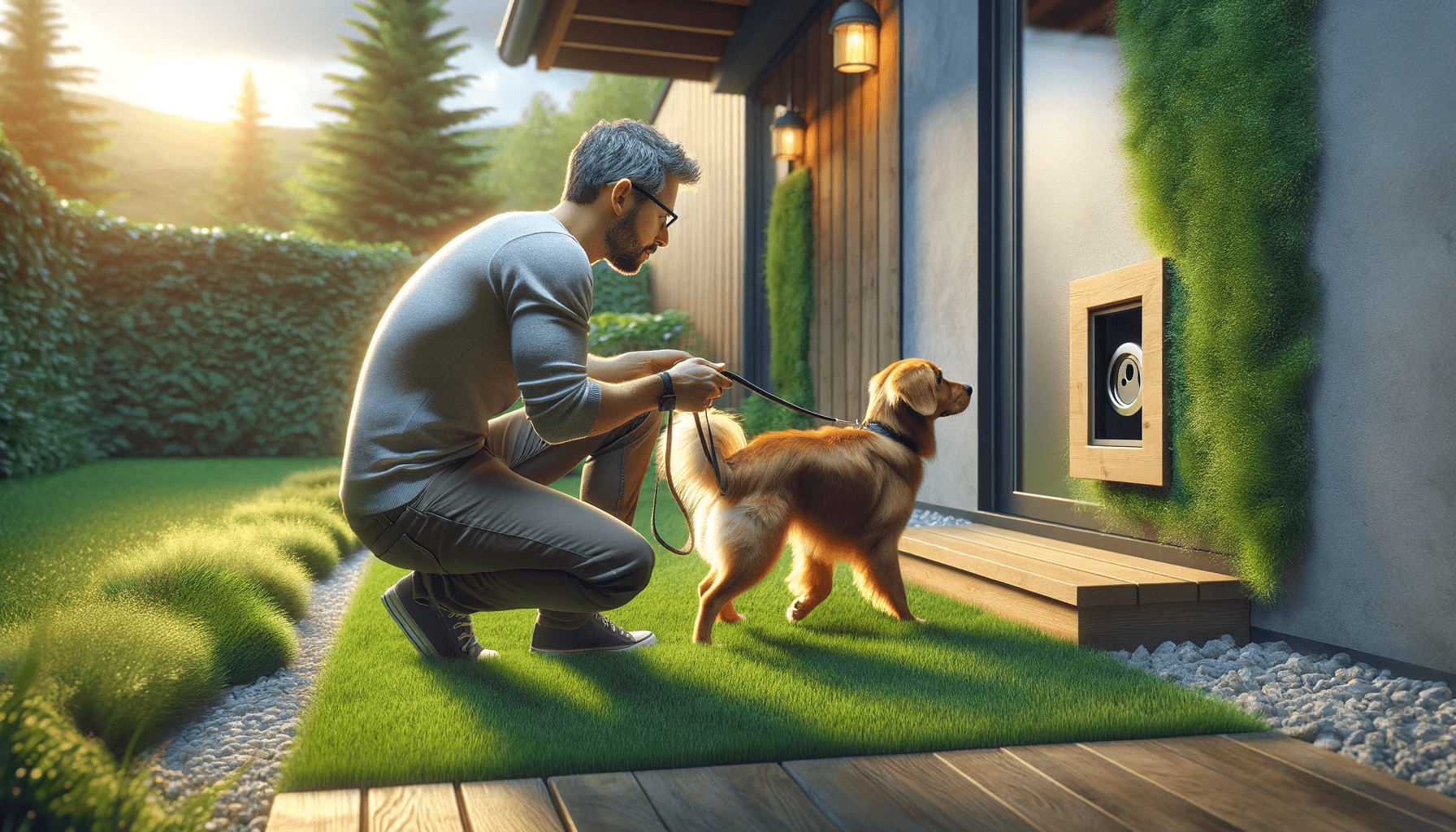Are you struggling with your dog's leash reactivity? Don't worry, there are innovative training techniques that can help you overcome this challenge.
In this article, we will guide you through understanding leash reactivity, identifying triggers, and implementing counterconditioning and desensitization exercises.
With positive reinforcement training methods and effective management strategies, you can transform your walks into enjoyable experiences for both you and your furry friend.
Remember, seeking professional help and support is always an option on this journey.
Key Takeaways
- Leash reactivity is a common behavioral issue in dogs that can affect their well-being and quality of life.
- Identifying triggers and thresholds is important in managing leash reactivity.
- Counterconditioning and desensitization techniques can help change a dog's emotional response to triggers.
- Positive reinforcement training methods, such as reward-based leash training and clicker training, can effectively overcome leash reactivity.
Understanding Leash Reactivity
To better understand leash reactivity, start by recognizing that it's a common behavioral issue in dogs.
Many owners often have misconceptions about leash reactivity, which can hinder their ability to address and manage the problem effectively. One common misconception is that leash reactivity is solely caused by aggression. However, leash reactivity can stem from fear, anxiety, or frustration, rather than aggression towards other dogs or people.
It's essential to understand that leash reactivity can have a significant impact on a dog's overall well-being. Dogs that display leash reactivity may experience heightened stress levels, which can lead to physical and emotional strain. This can result in a decrease in their quality of life, as well as create challenges in their daily routines and social interactions.
Understanding the underlying causes of leash reactivity and its impact on a dog's well-being is crucial for implementing effective training techniques and improving their overall behavior. By addressing leash reactivity, owners can help their dogs lead happier and more balanced lives.
Identifying Triggers and Thresholds
Start by observing your dog's behavior and identifying the specific triggers that cause their leash reactivity. This step is crucial in addressing the issue effectively. Here are some tips to help you identify triggers and set boundaries for your reactive pup:
- Observe body language: Pay attention to your dog's body language when they react on the leash. Look for signs of fear, anxiety, or aggression, such as growling, barking, or pulling.
- Take note of the environment: Notice the specific situations or locations where your dog tends to react. It could be encountering other dogs, unfamiliar people, or certain noises.
- Keep a behavior journal: Document your observations in a behavior journal. Note down the triggers, your dog's reactions, and any patterns you notice. This will help you identify common triggers and track progress over time.
- Manage exposure: Once you've identified the triggers, you can begin setting boundaries. Gradually expose your dog to these triggers in a controlled manner, using positive reinforcement techniques to encourage calm behavior.
- Seek professional help if needed: If your dog's reactivity persists or worsens despite your efforts, consider seeking guidance from a professional dog trainer or behaviorist. They can provide personalized strategies and support.
Identifying triggers and setting boundaries is an essential part of addressing leash reactivity. By understanding what causes your dog's reactions, you can develop effective training techniques to help them overcome their reactivity and enjoy walks with you.
Counterconditioning Techniques
Now that you have identified the triggers and set boundaries for your reactive pup, how can you use counterconditioning techniques to address their leash reactivity? Counterconditioning is a highly effective method for changing your dog's emotional response to their triggers. The goal is to replace the negative association with a positive one, ultimately reducing their reactivity.
To start, choose a trigger that's just below their threshold and begin the counterconditioning process. This could be a person or another dog at a distance where your dog can still remain calm. As soon as your dog sees the trigger, offer them a high-value treat or engage in a fun game. The idea is to create a positive association between the trigger and something they love.
As your dog becomes more comfortable, gradually decrease the distance between them and the trigger. Remember to always reward them for their calm behavior. It's important to go at your dog's pace and not rush the process.
Tracking your counter conditioning progress is crucial. Keep a record of your sessions, noting any improvements or setbacks. This will help you understand your dog's progress and make any necessary adjustments to the training plan.
Additionally, incorporating training distractions can be beneficial. By introducing controlled distractions during counterconditioning sessions, such as toys or other obedience commands, you can help your dog learn to focus on you rather than their triggers.
Desensitization Exercises
Now let's talk about desensitization exercises, which are a key component in overcoming leash reactivity.
These exercises involve gradually exposing your dog to their triggers in a controlled and safe manner. By starting at a distance where your dog is still comfortable and using positive reinforcement techniques, such as rewards, you can help counter-condition their reaction to these triggers.
Gradual Exposure to Triggers
You can effectively improve your dog's leash reactivity by gradually exposing them to triggers through desensitization exercises. This technique, known as gradual exposure, involves introducing your dog to the trigger in a controlled and gradual manner.
Here are five key techniques to help you implement gradual exposure effectively:
- Start with a distance: Begin the training with your dog at a comfortable distance from the trigger.
- Use positive reinforcement: Reward your dog with treats or praise when they remain calm in the presence of the trigger.
- Gradually decrease the distance: Over time, gradually decrease the distance between your dog and the trigger.
- Practice consistency: Consistency is key in desensitization exercises. Regularly expose your dog to the trigger to reinforce positive behavior.
- Seek professional help if needed: If your dog's leash reactivity persists or worsens, consider seeking guidance from a professional trainer or behaviorist.
Counter-Conditioning With Rewards
Building on the previous technique of gradual exposure, a highly effective method for overcoming leash reactivity is counter-conditioning with rewards through desensitization exercises. This approach involves using reward-based training and positive reinforcement techniques to change your dog's emotional response to triggers. The idea is to associate the presence of the trigger with something positive, such as treats or praise, in order to create a new, positive association in your dog's mind.
To start, identify the specific triggers that cause your dog to react on the leash. Then, gradually expose your dog to these triggers from a distance where they're still comfortable and not reactive. As your dog remains calm, reward them with treats or praise. Over time, gradually decrease the distance between your dog and the trigger, continuing to reward them for calm behavior.
Positive Reinforcement Training Methods
Now let's talk about the positive reinforcement training methods that can help overcome leash reactivity.
Reward-based leash training is all about using treats, toys, or praise to reward your dog for calm behavior on the leash.
Clicker training for reactivity involves using a clicker to mark and reinforce desired behaviors, helping your dog associate positive experiences with being on the leash.
Counter-conditioning with treats involves pairing the presence of triggers with high-value treats to change your dog's emotional response.
These methods can be effective in teaching your dog to have a positive association with the leash and reduce reactivity.
Reward-Based Leash Training
Using reward-based leash training techniques can effectively address leash reactivity in dogs. By focusing on positive reinforcement, you can train your dog to associate good behavior with rewards, making the leash a positive experience rather than a source of stress.
Here are some key benefits of reward-based leash training:
- Creates a positive association: Rewarding your dog for good behavior helps them associate the leash with positive experiences, reducing reactivity.
- Builds trust and bond: Positive reinforcement strengthens the bond between you and your dog, creating a foundation of trust and cooperation.
- Encourages desired behavior: By rewarding desired behaviors like walking without pulling or ignoring distractions, you reinforce these behaviors and discourage reactive responses.
- Reduces anxiety and fear: Positive reinforcement helps your dog feel more secure and confident, reducing their anxiety and fearfulness on the leash.
- Improves overall obedience: Reward-based training methods promote general obedience and responsiveness, translating to better behavior both on and off the leash.
With consistent and positive training, you can help your dog overcome leash reactivity and enjoy walks together.
Clicker Training for Reactivity
To address leash reactivity, incorporate clicker training as a positive reinforcement technique. Clicker training is a method that uses a small handheld device, called a clicker, to mark desired behaviors in dogs. This technique has several benefits when it comes to addressing reactivity on leash.
First, clicker training allows for precise timing in marking the desired behavior, which helps the dog understand what they're being rewarded for.
Second, it helps create a positive association with the trigger that causes reactivity, as the clicker is always followed by a treat or reward. This helps to change the dog's emotional response to the trigger over time.
Lastly, clicker training allows for clear communication between you and your dog, making the training process more effective and efficient.
Counter-Conditioning With Treats
Continue building on the progress made through clicker training by incorporating counter-conditioning with treats as part of your positive reinforcement training methods for leash reactivity. Treat motivation is a powerful tool in reward-based behavior modification, helping your dog associate positive experiences with previously triggering stimuli.
Here are five key benefits of using treats for counter-conditioning:
- Increased engagement: Treats create excitement and focus, keeping your dog's attention on you during training sessions.
- Positive association: The use of treats helps your dog develop a positive association with the trigger, gradually reducing reactivity.
- Reinforcement of desired behavior: Treats serve as a reward for calm and controlled behavior, reinforcing good habits.
- Motivation for learning: The anticipation of treats motivates your dog to actively participate in training exercises.
- Bonding and trust-building: Offering treats during counter-conditioning sessions strengthens the bond between you and your dog, promoting trust and cooperation.
Implementing Management Strategies
Your dog's leash reactivity can be effectively managed with the implementation of proper strategies. Managing leash reactivity is crucial for creating a safe and enjoyable walking experience for both you and your dog.
Leash reactivity prevention should start with identifying triggers and avoiding them whenever possible. By knowing what triggers your dog's reactivity, you can plan your walks in a way that minimizes exposure to those triggers. This may involve choosing less crowded routes or walking at quieter times of the day.
In addition to avoiding triggers, using management tools can be helpful in controlling your dog's reactivity. The use of a front-clip harness or a head halter can provide you with more control and make it easier to redirect your dog's attention. These tools can also help prevent your dog from pulling or lunging towards other dogs or people.
Another effective management strategy is to create distance between your dog and the trigger. By increasing the distance, you can give your dog more space and time to process the situation, reducing their reactivity. This may involve crossing the street, moving to the side, or finding a different path altogether.
Implementing proper management strategies is essential for successfully handling leash reactivity. By avoiding triggers, using management tools, and creating distance, you can help your dog feel more comfortable and confident during walks. Remember to always consult with a professional dog trainer or behaviorist for personalized guidance and support.
Seeking Professional Help and Support
If you're struggling to manage your dog's leash reactivity, seeking professional help and support can be a game-changer. Leash reactivity can be a challenging behavior to address on your own, and seeking professional guidance can provide you with the tools and techniques necessary to effectively manage and modify your dog's behavior.
Here are a few reasons why seeking professional help and finding support groups can greatly benefit you and your dog:
- Expertise: Professionals who specialize in dog behavior and training have the knowledge and experience to assess your dog's leash reactivity and develop a customized training plan that suits your dog's specific needs.
- Objective perspective: Professionals can offer an objective viewpoint and identify any underlying triggers or issues contributing to your dog's leash reactivity. This can help you gain a better understanding of your dog's behavior and how to address it.
- Training techniques: Professionals can teach you effective training techniques to desensitize and counter-condition your dog's response to triggers, helping them remain calm and focused on walks.
- Accountability: Working with a professional provides accountability, ensuring that you stay consistent with the training plan and make progress towards overcoming leash reactivity.
- Support groups: Joining support groups or online forums can connect you with other dog owners who are going through similar challenges. Sharing experiences, tips, and success stories can provide encouragement and motivation throughout your training journey.
Frequently Asked Questions
What Are Some Common Mistakes Dog Owners Make When Trying to Address Leash Reactivity?
Common mistakes when addressing leash reactivity include lack of consistency and using punishment-based techniques. It's important to understand that breed can play a role in leash reactivity, but with proper training, it is possible to eliminate or manage it. Counterconditioning can show improvement, but the time it takes varies. Alongside positive reinforcement, other effective training methods for leash reactivity include desensitization and using tools like front-clip harnesses.
Are There Any Specific Dog Breeds That Are More Prone to Leash Reactivity?
Some specific dog breeds may be more prone to leash reactivity due to genetics. It's important to understand that genetics can play a role, but leash reactivity can be addressed with innovative training techniques.
Can Leash Reactivity Be Completely Eliminated With Training, or Is It Something That a Dog Will Always Struggle With to Some Extent?
Can leash reactivity be completely eliminated through training, or will dogs always struggle to some extent? Training can greatly reduce leash reactivity, but complete elimination may not be possible for all dogs.
How Long Does It Typically Take to See Progress When Using Counterconditioning Techniques for Leash Reactivity?
When using counterconditioning techniques for leash reactivity, progress can vary. It's important to measure progress by assessing your dog's reactions and behavior over time. To maintain progress and prevent regression, consistency and continued practice are key.
Are There Any Alternative Training Methods or Tools That Can Be Used Alongside Positive Reinforcement Training to Address Leash Reactivity?
There are alternative training methods and tools you can use alongside positive reinforcement training to address leash reactivity. These methods and tools can help in overcoming leash reactivity and make walks more enjoyable for both you and your dog.
Conclusion
In conclusion, overcoming leash reactivity requires understanding the triggers and thresholds of your dog.
Implementing counterconditioning and desensitization techniques is crucial in helping your dog become more comfortable and less reactive on the leash.
Utilizing positive reinforcement training methods is also essential in teaching your dog alternative behaviors and rewarding calm and relaxed behavior.
It's important to also incorporate management strategies, such as avoiding triggers or using a head halter or front-clip harness, to prevent reactive episodes while working on training.
Additionally, seeking professional help and support can provide guidance and expertise in tackling leash reactivity.
By following these innovative training techniques and incorporating management strategies, you can help your dog overcome leash reactivity and enjoy walks without stress or anxiety.






